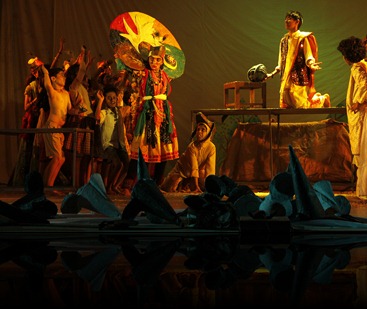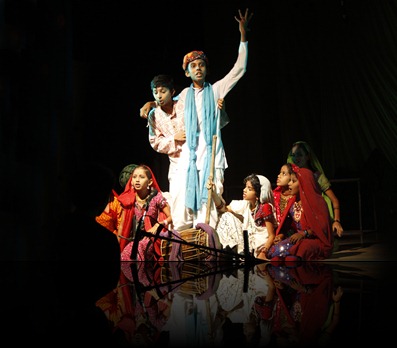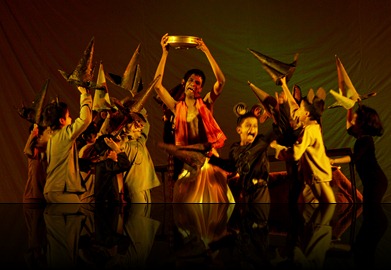A journey through Bommanahalli
First Published : 18 May 2010 01:03:00 AM IST
The New Indian Express daily
KOCHI: The aspirants of Mazhavillu, children’s wing of Lokadharmi theatre transported the audience to Bommanahalli and its milieu with vibrancy and ease. Bommanahalliyile Kinnara Yogi, the colourful adaptation of Browning’s poem by Kuvempu came alive on stage in Chandradasan’s hands as he blended the local, national and global aesthetics with his apt design, script and direction. Legends, myths, rituals, traditions and beliefs that ruled the villagers of yore took one back in time even as they rang a bell of contemporary realities.
All the 33 kids, a few changing roles now and then to bring to life a village setting, did justice to their characters.
They seemed to enjoy every moment on stage making the character come alive.
From start they lured the audience with their passionate performance like the Yogi who magnetised the rats and later kids with his music on the ‘kinnara’.
 This poetic drama began with song and dance, with the chorus enlightening the viewers wherever required.
This poetic drama began with song and dance, with the chorus enlightening the viewers wherever required.
One can sense the mood of the villagers. Like today the people are unhappy with the authority. Village chieftain Gowda lacks vision and dreams only of minting money, threatening the people with dire consequences if they don’t pay taxes. The villagers are burdened with a new problem - vermin menace. The bold and naughty rats stop at nothing. They eat food, destroy clothes and one even steals the chieftain’s turban and places it on its head to be leader. He manages his clan better than Gowda does, always scheming and plotting ways to overcome the traps laid by the villagers. They easily capture the rat-trap man, they create havoc at the rat yagna. They kill the cat and attack the dog. Repeated complaints and his own bitter experiences with the pests prompt Gowda to offer 6000 gold coins to anyone who can solve the problem. All look out for ideas and they see the dramatic arrival of Yogi accompanied by his people dancing his way through the audience to the stage. He stuns them with his song, dance and tales about his skill to rid rats in Kailasa and Vaikunta.
He demands a price and is satisfied by 6000 gold coins. Gowda falls at his feet and pleads for help. The Yogi like the Pied Piper charms the rats with his music and leads them to a river where all but one perish, which relates the plight of his companions and begs for mercy which is granted. The rats symbolically throw their masks into the river and don the role of village children who are lured away by the Yogi in retaliation of the chieftain’s refusal to pay the promised money. A lame child is left lamenting. The people who forgave the lonely rat are full of hate for the Yogi. The play does not end there, the villagers take you off stage where the Yogi is burned in effigy (reminiscent of rituals and Ramlila in which the victory of good over evil is celebrated by burning effigies), with all the characters singing and dancing around.
The Yogi is believed to visit the village every year to seek his reward. The play is layered with political, cultural and ecological implications which are not lost with kids taking on mature roles.
The conflict between Gowda and the people, the rats and the villagers, Gowda and Yogi, cat and rats, dog versus rats say much about mutual coexistence of man and animals.
Smooth dialogue delivery, change of scene and roles and natural acting accentuated by song, dance, music and lighting, simple narration, apt props and the style of presentation with many narrative forms and traditions, apt props made the show entertaining and though-provoking. Each kid was lost in his or her role taking the audience to the rustic simplicity of village life in general and Bommanahalli of Yore in particular.
Courtesy: The new Indian Express
Stills: Jipson
Labels: Bommanahalliyile Kinnara Yogi, Chandradasan, children's Theatre, Lokadharmi, Mazhavillu



